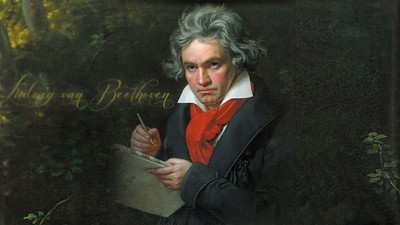Spring is here. Albeit a little earlier than usual. In fact, the first day of spring 2020 is unlike any we have seen in more than a century: it happened on March 19th.
This Spring is different in more profoundly important way as well. With the current outbreak of the COVID-19 virus, the celebration of Spring is not what we are used to. It feels strange to write an ode to Spring, but now is an ideal time to practise tenderness, not only with yourself but with the world around you.
We want to take this moment to shine a light on the tenderness of Nature, casting aside the harshness of winter (definitely true for us here in Canada) for brighter days. And there is no composer who captures the sights, sounds, and feelings of Spring like Vivaldi did.
There is no doubt that you have heard at least a small part of his The Four Seasons (Italian: Le quattro stagioni). Music from this group of four violin concerti has been featured in at least 100 different films and television shows, countless commercials, and wedding ceremonies across the globe. If you listen closely enough, you can probably hear it playing somewhere.
Published in 1725, The Four Seasons gives a musical expression to each season of the year. Of his 500+ concertos for violin, cello, flute, lute, and other instruments, as well as 90 sonatas, 46 operas, and large collection of sacred choral works and chamber music, it has stood the test of time as his most famous work.
Before we celebrate the The Four Seasons, with an emphasis on Spring, we should get to know a little more about Vivaldi and his influence on Classical music.
A Baroque Master
Antonio Vivaldi is regarded as one of the greatest Baroque composers. His influence was widespread across Europe during his lifetime.
Vivaldi was born on March 4, 1678, in Venice, Italy. There was a massive earthquake that very same day, and baby Vivaldi was baptized immediately after birth because of this.
He became a priest at the age of 15, and became known as “The Red Priest” because of his curly red hair, inherited from his father. He withdrew from the priesthood after 1.5 years due to frail health.
One of Vivaldi’s greatest admirers was Johann Sebastian Bach. Bach transcribed several of Vivaldi’s concertos for keyboard, strings, organ, and harpsichord.
Sadly, Vivaldi died in poverty at the age of 63 and was given a simple funeral in Vienna in 1741. The graveyard was abandoned in 1783, and in 1818 The Vienna University of Technology was built on its grounds. Today there is a plaque on its walls commemorating the burial place of this outstanding composer.
An Enduring Piece of Classical Music: The Four Seasons
Vivaldi composed his most famous series of violin concertos, The Four Seasons, in 1723. The inspiration for the concertos was probably the Italian countryside around Mantua.
The concertos beautifully capture the lively essence of each of the four seasons. Vivaldi even wrote pieces of poetry on the manuscript for each season. Each season contains three movements with tempos in the following order: fast-slow-fast.
What is remarkable, and revolutionary, about the concertos of The Four Seasons is their extraordinary programmatic imagination (which Vivaldi managed to counterbalance via close attention to formal structure).
The Beauty of Spring
The timelessness of this music stems from its ability to evoke something extra-musical. Program Music, as it’s formally called, was an art form which Vivaldi was determined to prove sophisticated enough to be taken seriously.
Listening to Spring is like stepping into the natural world, making you feel the sights, sounds, and smells of the season. They were a revolution in musical conception. Flowing creeks, singing birds, barking dogs, crying shepherds, storms are all expressed so vividly in the strings.
Vivaldi took great pains to relate his music to the texts of the poems, translating the poetic lines themselves directly into the music on the page. It is believed that Vivladi composed the texts.
Reading the poems and then listening to the music is an amazing way to transform what you're hearing. Here is the Spring Sonata:
Springtime is upon us.
The birds celebrate her return with festive song,
and murmuring streams are
softly caressed by the breezes.
Thunderstorms, those heralds of Spring, roar,
casting their dark mantle over heaven,
Then they die away to silence,
and the birds take up their charming songs once more.
On the flower-strewn meadow, with leafy branches
rustling overhead, the goat-herd sleeps,
his faithful dog beside him.
Led by the festive sound of rustic bagpipes,
nymphs and shepherds lightly dance
beneath the brilliant canopy of spring.
Bask in the arrival of Spring, turn on this concerto and be greeted by the clarity and crispness of a typical spring day, with choirs of birds and streams. Embrace the sudden thunderstorm, knowing that the singing birds will soon regain dominance. Revel in the lively country dance, celebrating the return of fauna and flora after a harsh winter. We can’t think of a better way to welcome the sunshine.
Listening to Baroque Classical Music on Calm Radio
Listen to calming Vivaldi classical baroque music on our free relaxing Baroque channel.
Baroque music forms a major portion of the "classical music" canon, being widely studied, performed, and listened to. In addition to the free peaceful relaxing calming Vivaldi baroque music we offer the calm baroque music of JS Bach, George Frideric Handel, Alessandro Scarlatti, Domenico Scarlatti, Georg Philipp Telemann, Jean-Baptiste Lully, Arcangelo Corelli, François Couperin, Denis Gaultier, Claudio Monteverdi, Jean-Philippe Rameau and Henry Purcell.
Experience this channel and over 1000 online relaxing music channels by signing up for a free or premium membership from Calm Radio.
Happy listening!




